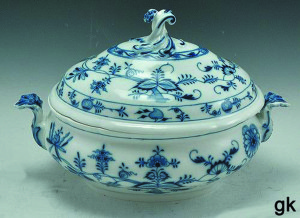Its time to bring the almost forgotten tureen back to the dinner table. Give a little elegance to crock pot food with a vintage or antique tureen.
When they were first introduced in the late 17th century, tureens of silver and fine porcelain graced royal tables. At the same time pottery tureens appeared on peasant’s tables, primarily for soup.
The earliest tureens came with platters or stands that have long since disappeared. Smaller tureens were used for gravy or sauces. By the Victorian era they were an important part of a huge dinner service. In the 20th century they were no longer a part of everyday dining.
Over the years their materials varied from sterling silver and Sheffield plate to porcelain, pottery and pewter. These days collectors look for those made of Majolica pottery with colorful, raised motifs, and often in animal, fish or vegetable shapes.
Early pottery and porcelain tureens often copied the current silver shapes. Tin glazed(faience) pottery was made in many countries during the 18th century. Colorful examples were made in Spain, France and Germany. By the 19th century shapes included round and oval.
Chinese export porcelain dinner services had become popular in America and elsewhere by the late 18th century. Inexpensive at the time, when soup tureens from those dinner services show up at auctions and shows, prices can run into the thousands of dollars.
Most familiar these days are the tureens made in Staffordshire, England in the 19th century for the American market. They are known as “American Historical Views, “ depicting famous American landmarks, events and places. The scenes were transfer printed with borders and rims in floral and shell motifs that were unique to each factory. While dark blue is the color most associated with the wares, they also came in purple, black, brown and rose.
CLUES: Reproductions of antique tureens are a problem with blue and white Chinese Export and 18th century “Chelsea” rabbit tureens. The rabbit tureen was faked by Emile Samson during the late 19th century. However, fakes by Samson have become collectible in their own right.
Many English firms have reproduced the early Staffordshire types, However they will say “England” on the bottom.
PHOTO CAPTION: C. 1900 Meissen soup tureen. Blue onion pattern. PHOTO CREDIT: grandmasattic3. EBay.
















Follow Us